Related Research Articles

A fixed-wing aircraft is a flying machine, such as an airplane, which is capable of flight using wings that generate lift caused by the aircraft's forward airspeed and the shape of the wings. Fixed-wing aircraft are distinct from rotary-wing aircraft, and ornithopters. The wings of a fixed-wing aircraft are not necessarily rigid; kites, hang gliders, variable-sweep wing aircraft and airplanes that use wing morphing are all examples of fixed-wing aircraft.

A delta wing is a wing shaped in the form of a triangle. It is named for its similarity in shape to the Greek uppercase letter delta (Δ).
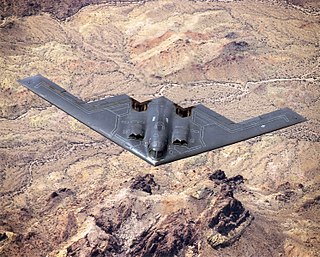
A flying wing is a tailless fixed-wing aircraft that has no definite fuselage. The crew, payload, fuel, and equipment are typically housed inside the main wing structure, although a flying wing may have various small protuberances such as pods, nacelles, blisters, booms, or vertical stabilizers.
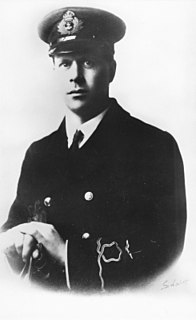
Sir Barnes Neville Wallis, was an English scientist, engineer and inventor. He is best known for inventing the bouncing bomb used by the Royal Air Force in Operation Chastise to attack the dams of the Ruhr Valley during World War II.

A variable-sweep wing, colloquially known as a "swing wing", is an airplane wing, or set of wings, that may be swept back and then returned to its original straight position during flight. It allows the aircraft's shape to be modified in flight, and is therefore an example of a variable-geometry aircraft.
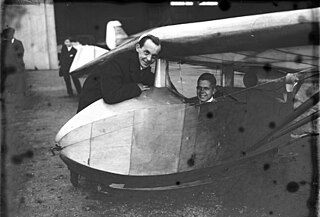
Alexander Martin Lippisch was a German aeronautical engineer, a pioneer of aerodynamics who made important contributions to the understanding of tailless aircraft, delta wings and the ground effect, and also worked in the U.S. His most famous designs are the Messerschmitt Me 163 rocket-powered interceptor and the Dornier Aerodyne.

The empennage, also known as the tail or tail assembly, is a structure at the rear of an aircraft that provides stability during flight, in a way similar to the feathers on an arrow. The term derives from the French language word empenner which means "to feather an arrow". Most aircraft feature an empennage incorporating vertical and horizontal stabilising surfaces which stabilise the flight dynamics of yaw and pitch, as well as housing control surfaces.

An aircraft stabilizer is an aerodynamic surface, typically including one or more movable control surfaces, that provides longitudinal (pitch) and/or directional (yaw) stability and control. A stabilizer can feature a fixed or adjustable structure on which any movable control surfaces are hinged, or it can itself be a fully movable surface such as a stabilator. Depending on the context, "stabilizer" may sometimes describe only the front part of the overall surface.

An oblique wing is a variable geometry wing concept. On an aircraft so equipped, the wing is designed to rotate on center pivot, so that one tip is swept forward while the opposite tip is swept aft. By changing its sweep angle in this way, drag can be reduced at high speed without sacrificing low speed performance. This is a variation on the classic swing-wing design, intended to simplify construction and retain the center of gravity as the sweep angle is changed.
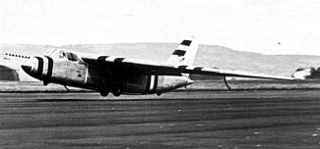
The Short SB.1 was a British tailless glider designed by David Keith-Lucas and Professor Geoffrey T.R. Hill. Built by Shorts as a private research venture to test the concept of the aero-isoclinic wing, it was the first aircraft to incorporate this feature.
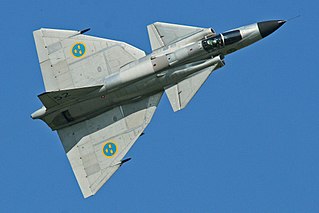
A canard is an aeronautical arrangement wherein a small forewing or foreplane is placed forward of the main wing of a fixed-wing aircraft. The term "canard" may be used to describe the aircraft itself, the wing configuration, or the foreplane.

Pterodactyl was the name given to a series of experimental tailless aircraft designs developed by G. T. R. Hill in the 1920s and early 1930s. Named after the genus Pterodactylus, a well-known type of Pterosaur commonly known as the pterodactyl, all but the first were produced by Westland Aircraft Ltd after Hill joined them.

A tailless aircraft has no tail assembly and no other horizontal surface besides its main wing. The aerodynamic control and stabilisation functions in both pitch and roll are incorporated into the main wing. A tailless type may still have a conventional vertical fin and rudder.

The Dunne D.5 was an experimental aircraft built in the United Kingdom in 1910. Designed by J. W. Dunne and built by Short Brothers at Leysdown, A tailless swept-wing biplane, the D.5 was the first aircraft built by his company, the Blair Atholl Aeroplane Syndicate Ltd. Like its military predecessors it was driven by twin pusher propellers, but it had a considerably more powerful engine.
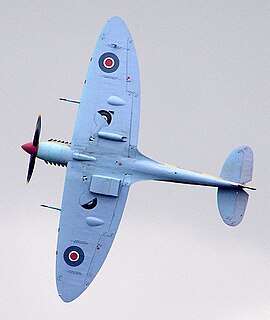
The wing configuration of a fixed-wing aircraft is its arrangement of lifting and related surfaces.

BAC/Dassault AFVG was a 1960s project for supersonic multi-role combat aircraft with a variable-sweep wing, jointly developed by British Aircraft Corporation in the United Kingdom and Dassault Aviation of France.
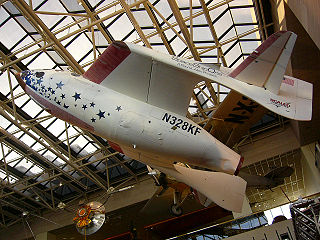
An outboard tail is a type of aircraft tail or empennage which is split in two, with each half mounted on a short boom just behind and outboard of each wing tip. It comprises outboard horizontal stabilizers (OHS) and may or may not include additional boom-mounted vertical stabilizers (fins). OHS designs are sometimes described as a form of tailless aircraft.

Tu-130 was a concept for a boost-glider launched by an intercontinental three-stage missile by Soviet designer Tupolev.

The Vickers Swallow was a supersonic aircraft project headed by Barnes Wallis, working at the British aircraft company Vickers-Armstrongs. It was a wing controlled aerodyne, controlled in flight by movement of the entire wing, and was the supersonic successor to the Wild Goose project.
References
Bibliography
- J.E. Morpurgo; Barnes Wallis: A Biography, 2nd Edn, 1981. (1st Edn, Longmans, 1972).